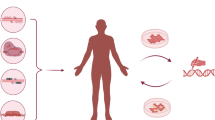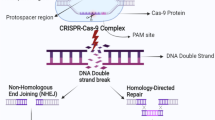Abstract
The precise and simultaneous acquisition of multiple beneficial alleles in the genome is in great demand for the development of elite pig breeders. Cytidine base editors (CBEs) that convert C:G to T:A have emerged as powerful tools for single-nucleotide replacement. Whether CBEs can effectively mediate C-to-T substitution at multiple sites/loci for trait improvement by direct zygote injection has not been verified in large animals. Here, we determined the editing efficiency of four CBE variants in porcine embryonic fibroblast cells and embryos. The findings showed that hA3A-BE3-Y130F and hA3A-eBE-Y130F consistently resulted in increased base-editing efficiency and low toxic effects in embryonic development. Further, we verified that using a one-step approach, direct zygote microinjection of the CBE system can generate pigs harboring multiple point mutations. Our process resulted in a stop codon in CD163 and myostatin (MSTN) and introduced a beneficial allele in insulin-like growth factor-2 (IGF2). The pigs showed disrupted expression of CD163 and MSTN and increased expression of IGF2, which significantly improved growth performance and infectious disease resistance. Our approach allows immediate introduction of multiple mutations in transgene-free animals to comprehensively improve economic traits through direct embryo microinjection, providing a potential new route to produce elite pig breeders.
Similar content being viewed by others
References
Bae, S., Park, J., and Kim, J.S. (2014). Cas-OFFinder: a fast and versatile algorithm that searches for potential off-target sites of Cas9 RNA-guided endonucleases. Bioinformatics, 30, 1473–1475.
Burkard, C., Opriessnig, T., Mileham, A.J., Stadejek, T., Ait-Ali, T., Lillico, S.G., Whitelaw, C.B.A., and Archibald, A.L. (2018). Pigs lacking the scavenger receptor cysteine-rich domain 5 of CD163 are resistant to porcine reproductive and respiratory syndrome virus 1 infection. J Virol, 92, e00415.
Cheng, T.L., Li, S., Yuan, B., Wang, X., Zhou, W., and Qiu, Z. (2019). Expanding C-T base editing toolkit with diversified cytidine deaminases. Nat Commun, 10, 3612.
Clark, D.L., Clark, D.I., Hogan, E.K., Kroscher, K.A., and Dilger, A.C. (2015). Elevated insulin-like growth factor 2 expression may contribute to the hypermuscular phenotype of myostatin null mice. Growth Hormone IGF Res, 25, 207–218.
Gehrke, J.M., Cervantes, O., Clement, M.K., Wu, Y., Zeng, J., Bauer, D.E., Pinello, L., and Joung, J.K. (2018). An APOBEC3A-Cas9 base editor with minimized bystander and off-target activities. Nat Biotechnol, 36, 977–982.
Gu, H., Zhou, Y., Yang, J., Li, J., Peng, Y., Zhang, X., Miao, Y., Jiang, W., Bu, G., Hou, L., et al. (2021). Targeted overexpression of PPARγ in skeletal muscle by random insertion and CRISPR/Cas9 transgenic pig cloning enhances oxidative fiber formation and intramuscular fat deposition. FASEB J, 35, e21308.
Huang, X.J., Zhang, H.X., Wang, H., Xiong, K., Qin, L., and Liu, H. (2014). Disruption of the myostatin gene in porcine primary fibroblasts and embryos using zinc-finger nucleases. Mol Cells, 37, 302–306.
Kim, K., Ryu, S.M., Kim, S.T., Baek, G., Kim, D., Lim, K., Chung, E., Kim, S., and Kim, J.S. (2017). Highly efficient RNA-guided base editing in mouse embryos. Nat Biotechnol, 35, 435–437.
Koblan, L.W., Doman, J.L., Wilson, C., Levy, J.M., Tay, T., Newby, G.A., Maianti, J.P., Raguram, A., and Liu, D.R. (2018). Improving cytidine and adenine base editors by expression optimization and ancestral reconstruction. Nat Biotechnol, 36, 843–846.
Komor, A.C., Kim, Y.B., Packer, M.S., Zuris, J.A., and Liu, D.R. (2016). Programmable editing of a target base in genomic DNA without doublestranded DNA cleavage. Nature, 533, 420–424.
Komor, A.C., Zhao, K.T., Packer, M.S., Gaudelli, N.M., Waterbury, A.L., Koblan, L.W., Kim, Y.B., Badran, A.H., and Liu, D.R. (2017). Improved base excision repair inhibition and bacteriophage Mu Gam protein yields C:G-to-T:A base editors with higher efficiency and product purity. Sci Adv, 3, eaao4774.
Koppes, E.A., Redel, B.K., Johnson, M.A., Skvorak, K.J., Ghaloul-Gonzalez, L., Yates, M.E., Lewis, D.W., Gollin, S.M., Wu, Y.L., Christ, S.E., et al. (2020). A porcine model of phenylketonuria generated by CRISPR/Cas9 genome editing. JCI Insight, 5, e141523.
Li, W., Li, R., Wei, Y., Meng, X., Wang, B., Zhang, Z., Wu, W., and Liu, H. (2020). Effect of MSTN mutation on growth and carcass performance in Duroc×Meishan hybrid population. Animals, 10, 932.
Liang, P., Sun, H., Zhang, X., Xie, X., Zhang, J., Bai, Y., Ouyang, X., Zhi, S., Xiong, Y., Ma, W., et al. (2018). Effective and precise adenine base editing in mouse zygotes. Protein Cell, 9, 808–813.
Liang, P., Sun, H., Sun, Y., Zhang, X., Xie, X., Zhang, J., Zhang, Z., Chen, Y., Ding, C., Xiong, Y., et al. (2017). Effective gene editing by highfidelity base editor 2 in mouse zygotes. Protein Cell, 8, 601–611.
Liu, Z., Chen, M., Chen, S., Deng, J., Song, Y., Lai, L., and Li, Z. (2018). Highly efficient RNA-guided base editing in rabbit. Nat Commun, 9, 2717.
Martinet, C., Monnier, P., Louault, Y., Benard, M., Gabory, A., and Dandolo, L. (2016). H19 controls reactivation of the imprinted gene network during muscle regeneration. Development, 143, 962–971.
Miyake, M., Hayashi, S., Taketa, Y., Iwasaki, S., Watanabe, K., Ohwada, S., Aso, H., and Yamaguchi, T. (2010). Myostatin down-regulates the IGF-2 expression via ALK-Smad signaling during myogenesis in cattle. Anim Sci J, 81, 223–229.
Owen, J.R., Hennig, S.L., McNabb, B.R., Mansour, T.A., Smith, J.M., Lin, J.C., Young, A.E., Trott, J.F., Murray, J.D., Delany, M.E., et al. (2021). One-step generation of a targeted knock-in calf using the CRISPR-Cas9 system in bovine zygotes. BMC Genomics, 22, 118.
Park, D.S., Yoon, M., Kweon, J., Jang, A.H., Kim, Y., and Choi, S.C. (2017). Targeted base editing via RNA-guided cytidine deaminases in Xenopus laevis embryos. Mol Cells, 40, 823–827.
Qian, L., Tang, M., Yang, J., Wang, Q., Cai, C., Jiang, S., Li, H., Jiang, K., Gao, P., Ma, D., et al. (2015). Targeted mutations in myostatin by zincfinger nucleases result in double-muscled phenotype in Meishan pigs. Sci Rep, 5, 14435.
Sasaguri, H., Nagata, K., Sekiguchi, M., Fujioka, R., Matsuba, Y., Hashimoto, S., Sato, K., Kurup, D., Yokota, T., and Saido, T.C. (2018). Introduction of pathogenic mutations into the mouse Psen1 gene by Base Editor and Target-AID. Nat Commun, 9, 2892.
St Martin, A., Salamango, D., Serebrenik, A., Shaban, N., Brown, W.L., Donati, F., Munagala, U., Conticello, S.G., and Harris, R.S. (2018). A fluorescent reporter for quantification and enrichment of DNA editing by APOBEC-Cas9 or cleavage by Cas9 in living cells. Nucleic Acids Res, 46, e84.
Stinckens, A., Luyten, T., Van den Maagdenberg, K., Janssens, S., De Smet, S., Georges, M., and Buys, N. (2009). Interactions between genes involved in growth and muscularity in pigs: IGF-2, myostatin, ryanodine receptor 1, and melanocortin-4 receptor. Domest Anim Endocrinol, 37, 227–235.
Tanihara, F., Hirata, M., Nguyen, N.T., Le, Q.A., Wittayarat, M., Fahrudin, M., Hirano, T., and Otoi, T. (2021). Generation of CD163-edited pig via electroporation of the CRISPR/Cas9 system into porcine in vitrofertilized zygotes. Anim Biotechnol, 32, 147–154.
Van Breedam, W., Delputte, P.L., Van Gorp, H., Misinzo, G., Vanderheijden, N., Duan, X., and Nauwynck, H.J. (2010). Porcine reproductive and respiratory syndrome virus entry into the porcine macrophage. J Gen Virol, 91, 1659–1667.
Van Laere, A.S., Nguyen, M., Braunschweig, M., Nezer, C., Collette, C., Moreau, L., Archibald, A.L., Haley, C.S., Buys, N., Tally, M., et al. (2003). A regulatory mutation in IGF2 causes a major QTL effect on muscle growth in the pig. Nature, 425, 832–836.
Wang, X., Zhou, J., Cao, C., Huang, J., Hai, T., Wang, Y., Zheng, Q., Zhang, H., Qin, G., Miao, X., et al. (2015a). Efficient CRISPR/Cas9- mediated biallelic gene disruption and site-specific knockin after rapid selection of highly active sgRNAs in pigs. Sci Rep, 5, 13348.
Wang, Y., Du, Y., Shen, B., Zhou, X., Li, J., Liu, Y., Wang, J., Zhou, J., Hu, B., Kang, N., et al. (2015b). Efficient generation of gene-modified pigs via injection of zygote with Cas9/sgRNA. Sci Rep, 5, 8256.
Whitworth, K.M., Lee, K., Benne, J.A., Beaton, B.P., Spate, L.D., Murphy, S.L., Samuel, M.S., Mao, J., O’Gorman, C., Walters, E.M., et al. (2014). Use of the CRISPR/Cas9 system to produce genetically engineered pigs from in vitro-derived oocytes and embryos. Biol Reprod, 91, 78.
Whitworth, K.M., Rowland, R.R.R., Ewen, C.L., Trible, B.R., Kerrigan, M. A., Cino-Ozuna, A.G., Samuel, M.S., Lightner, J.E., McLaren, D.G., Mileham, A.J., et al. (2016). Gene-edited pigs are protected from porcine reproductive and respiratory syndrome virus. Nat Biotechnol, 34, 20–22.
Xiang, G., Ren, J., Hai, T., Fu, R., Yu, D., Wang, J., Li, W., Wang, H., and Zhou, Q. (2018). Editing porcine IGF2 regulatory element improved meat production in Chinese Bama pigs. Cell Mol Life Sci, 75, 4619–4628.
Xie, J., Ge, W., Li, N., Liu, Q., Chen, F., Yang, X., Huang, X., Ouyang, Z., Zhang, Q., Zhao, Y., et al. (2019). Efficient base editing for multiple genes and loci in pigs using base editors. Nat Commun, 10, 2852.
Xu, K., Zhou, Y., Mu, Y., Liu, Z., Hou, S., Xiong, Y., Fang, L., Ge, C., Wei, Y., Zhang, X., et al. (2020). CD163 and pAPN double-knockout pigs are resistant to PRRSV and TGEV and exhibit decreased susceptibility to PDCoV while maintaining normal production performance. eLife, 9, e57132.
Yang, D., Yang, H., Li, W., Zhao, B., Ouyang, Z., Liu, Z., Zhao, Y., Fan, N., Song, J., Tian, J., et al. (2011). Generation of PPARγ mono-allelic knockout pigs via zinc-finger nucleases and nuclear transfer cloning. Cell Res, 21, 979–982.
Yu, H.H., Zhao, H., Qing, Y.B., Pan, W.R., Jia, B.Y., Zhao, H.Y., Huang, X. X., and Wei, H.J. (2016). Porcine zygote injection with Cas9/sgRNA results in DMD-modified pig with muscle dystrophy. Int J Mol Sci, 17, 1668.
Zheng, Q., Lin, J., Huang, J., Zhang, H., Zhang, R., Zhang, X., Cao, C., Hambly, C., Qin, G., Yao, J., et al. (2017). Reconstitution of UCP1 using CRISPR/Cas9 in the white adipose tissue of pigs decreases fat deposition and improves thermogenic capacity. Proc Natl Acad Sci USA, 114, E9474–E9482.
Zhou, C., Sun, Y., Yan, R., Liu, Y., Zuo, E., Gu, C., Han, L., Wei, Y., Hu, X., Zeng, R., et al. (2019). Off-target RNA mutation induced by DNA base editing and its elimination by mutagenesis. Nature, 571, 275–278.
Zhu, X.X., Zhan, Q.M., Wei, Y.Y., Yan, A.F., Feng, J., Liu, L., Lu, S.S., and Tang, D.S. (2020). CRISPR/Cas9-ediated MSTN disruption accelerates the growth of Chinese Bama pigs. Reprod Dom Anim, 55, 1314–1327.
Zong, Y., Song, Q., Li, C., Jin, S., Zhang, D., Wang, Y., Qiu, J.L., and Gao, C. (2018). Efficient C-to-T base editing in plants using a fusion of nCas9 and human APOBEC3A. Nat Biotechnol, 36, 950–953.
Acknowledgements
This work was supported by the National Natural Science Foundation for Distinguished Young Scholars (31925036), the National Key Research and Development Program of China (2020YFC1316602), the National Natural Science Foundation of China (81671274, 31272440, and 31801031), the National Transgenic Project of China (2016ZX08009003-006-007), and the Elite Youth Program of the Chinese Academy of Agricultural Sciences (ASTIP-IAS05).
Author information
Authors and Affiliations
Corresponding authors
Additional information
Compliance and ethics
The author(s) declare that they have no conflict of interest.
Rights and permissions
About this article
Cite this article
Song, R., Wang, Y., Zheng, Q. et al. One-step base editing in multiple genes by direct embryo injection for pig trait improvement. Sci. China Life Sci. 65, 739–752 (2022). https://doi.org/10.1007/s11427-021-2013-8
Received:
Accepted:
Published:
Issue Date:
DOI: https://doi.org/10.1007/s11427-021-2013-8




